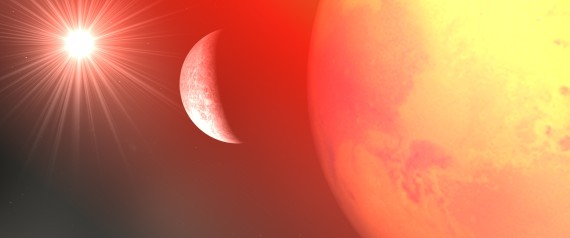First Alien Moon May Have Been Spotted, Astronomers Say
 |
By Clara Moskowitz
Posted: 12/23/2013 8:46 am EST
|
By Clara Moskowitz
Posted: 12/23/2013 8:46 am EST
The system showed up in a study using micro lensing, which looks for the bending of starlight due to the gravitational pull of an unseen object between a star and Earth. In this case the massive object might well be a planet and a moon. But the signal is not very clear, the researchers acknowledge, and could instead represent a dim star and a lightweight planet. “An alternate star-plus-planet model fits the data almost as well” as the planet-plus-moon explanation, the scientists reported in a paper that was posted this week on the preprint site arXiv. The study has not yet been peer-reviewed.
"I was excited by this paper," says astronomer Jean Schneider of the Paris Observatory, who was not involved in the research. Exomoons have "become fashionable these days," he adds, and are one of his personal "holy grails." Schneider wrote a paper in 1999 on how to detect exomoons using an alternative method, called transiting. (The transit technique looks for the dimming of a star's light caused when a planet or moon passes in front of the star from Earth's perspective).
Now that astronomers know planets are common in the galaxy, exomoons, too, are likely to abound, scientists say. Yet they are exceedingly hard to find, due to their diminutive size and lack of brightness. The authors of the new paper, led by David Bennett of the University of Notre Dame, note that micro lensing is promising because it can detect moons beyond the close-in satellites that transit searches are best equipped to find. Regardless of whether the new system turns out to include a moon, "these results indicate the potential of micro lensing to detect exomoons," the authors wrote.
Micro lensing is a type of gravitational lensing, an effect on light predicted by Albert Einstein's general theory of relativity. According to Einstein’s theory, massive objects warp the spacetime in their vicinity, so that anything, even light, will take a curved path around them. When light from a background star travels past a massive object on its way to our telescopes, it manifests in bright circles of warped light called Einstein rings. If the massive object consists of two bodies, such as a planet and its moon, the circle will appear broken and bulgy in places. Sometimes the ring is too small to resolve the details, but the overall micro lensing effect can be calculated by the way the star’s overall brightness varies in time.
Bennett and his colleagues have identified a two-body system, which they designate MOA-2011-BLG-262, from micro lensing data collected at the Mount John University Observatory in New Zealand and the Mount Canopus Observatory in Tasmania. But the researchers cannot be sure which two bodies caused the brightness fluctuations. The explanation that best fits the data is a giant planet, about four times the mass of Jupiter, orbited by a moon weighing less than Earth. If that interpretation is correct, the planet and its moon would be relatively nearby, between 1,000 and 2,000 light-years from Earth, and would be adrift in the Milky Way rather than part of a system circling one of the galaxy’s stars. Scientists think such free-floating objects might be relatively common, because gravitational interactions between multiple planets in a system can eject one or more of the planets entirely, perhaps with a moon in tow.
Another possibility is that the researchers have detected a more distant system comprising a small star, around one tenth the mass of the sun, and a planet roughly 18 times as massive as Earth. This system would need to be much farther away to explain the micro lensing pattern.
On the bright side, he says, the discovery has brought numerous surprises. It has highlighted the potential of micro lensing at a time when most of the field is focusing on the transit method, and it has potentially revealed a free-floating system whereas astronomers have mainly been looking for moons orbiting planets around stars. "It forces us," Schneider says, "to be always open-minded."
